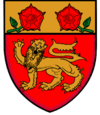Siege of Athlone
| Siege of Athlone | |||||||
|---|---|---|---|---|---|---|---|
| Part of the Williamite War in Ireland | |||||||
|
|||||||
| Belligerents | |||||||
| Jacobite forces | Williamite forces | ||||||
| Commanders and leaders | |||||||
| Clifford, D'Usson [1] | Godart de Ginkel | ||||||
| Strength | |||||||
| ? | ? | ||||||
| Casualties and losses | |||||||
| ? | ? | ||||||
Athlone in central Ireland, was besieged twice during the Williamite War in Ireland (1689–91). The town is situated on the River Shannon and commanded the bridge crossing the river into the Jacobite held province of Connaught. For this reason, it was of key strategic importance.
First siege, 1690
The Williamites first besieged Athlone in 1690, not long after their victory in the Battle of the Boyne. During this siege, they were commanded by William of Orange. They were, however, unsuccessful.
1691 siege
The following year in the Summer of 1691, the Williamites having regrouped at Mullingar [2] proceeded through the village of Ballymore and tried again to take Athlone,[3] this time led by Dutch general Godart de Ginkel.
An assault was made on the eastern part of Athlone on June 20, which caused the Jacobites to retreat across the Shannon to the west bank of the river, but on the way the rebels dismantled the bridge.[4]
The Jacobites garrison at the western half of Athlone led by Clifford, initially held off the Williamite assault by fierce fighting, centred on the bridge over the Shannon. The Williamites tried to lay planks over the partially wrecked structure, which the Irish Jacobite troops managed to destroy despite coming under intense fire. Several attempts by the Williamites to storm the bridge were repulsed with heavy losses.
The Williamite bombardment of the western, Connacht, side of the town was intense, with over 60,000 shot fired into the town over a ten-day period. One survivor described the scene, "with the balls and bombs flying so thick, that spot was hell on earth".[5]
However, Ginkel identified another crossing upriver and sent an elite grenadier force, 2,000 strong, to cross there and attack the Jacobite positions from the rear. The grenadiers manned the town's west-facing ramparts and held off Jacobite counter-attacks until the main Williamite force could be brought up.[6]
After this, the Jacobite garrison, who had been awaiting reinforcement from the main Jacobite force advancing from Limerick, hastily abandoned their positions in Athlone.
Ginkel and the Williamites went on to march on Limerick. On the march they were confronted by the main Jacobite army at the Battle of Aughrim and the Williamites inflicted a crushing defeat on them — effectively ending Jacobite resistance in Ireland.
References
- ↑ GA Hayes McCoy, Irish Battles p 246
- ↑ A Jacobite narrative of the war in Ireland (A light to the blind; Pluncket memoirs)
- ↑ http://books.google.fr/books?id=M4MPAAAAIAAJ&pg=RA1-PA746&lpg=RA1-PA74#PRA1-PA746,M1
- ↑ G.A. Hayes McCoy, Irish Battles, p245
- ↑ Padraig Lenihan, Consolidating Conquest, p185
- ↑ Lenihan p 185
| |||||||||||||||||||
